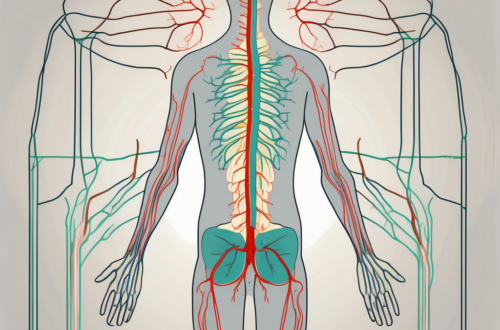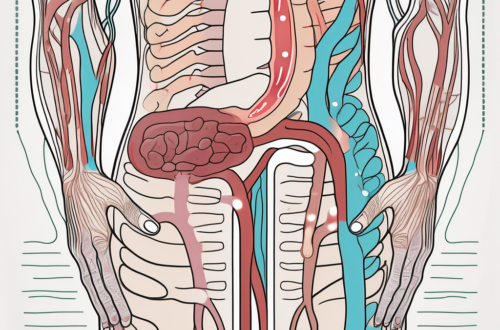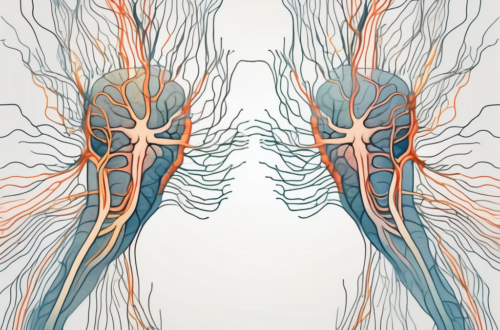The parasympathetic nervous system plays a crucial role in our body’s overall functioning. Despite primarily being associated with activities that promote relaxation, it also has a surprising impact on arousal, the state of being awake and alert. Understanding the intricate relationship between the parasympathetic nervous system and arousal can provide valuable insights into our daily lives.
Understanding the Parasympathetic Nervous System
To grasp the connection between the parasympathetic nervous system and arousal, it is essential to comprehend the functions and role of the parasympathetic nervous system itself. This branch of the autonomic nervous system operates alongside its counterpart, the sympathetic nervous system, to maintain homeostasis in the body.
The parasympathetic nervous system, often referred to as the “rest and digest” system, is responsible for promoting rest and relaxation. When activated, it regulates bodily activities that occur during times of rest and recovery, such as digestion, slowing heart rate, and promoting a calm state of mind. This system acts as a counterbalance to the sympathetic nervous system, which is responsible for the body’s fight-or-flight response.
The Role of the Parasympathetic Nervous System
One primary function of the parasympathetic nervous system is to promote rest and relaxation. When activated, it sends signals to various organs and tissues in the body, triggering a cascade of physiological responses that help the body recover and rejuvenate. For example, the parasympathetic nervous system stimulates the production of digestive enzymes and increases blood flow to the digestive organs, facilitating the process of nutrient absorption and waste elimination.
Furthermore, the parasympathetic nervous system plays a crucial role in regulating heart rate. It sends signals to the sinoatrial (SA) node, often referred to as the “natural pacemaker” of the heart, causing it to release electrical impulses at a slower rate. This results in a decrease in heart rate, allowing the body to conserve energy and promote a state of relaxation.
The Anatomy of the Parasympathetic Nervous System
The parasympathetic nervous system is closely connected to various parts of the body, including the brain, cranial nerves, and sacral nerves. The cranial nerves, specifically the vagus nerve, play a vital role in transmitting parasympathetic signals between the brain and the organs in the chest and abdomen. This extensive network of nerves allows for precise control and coordination of parasympathetic responses throughout the body.
In addition to the cranial nerves, the parasympathetic nervous system also utilizes the sacral nerves to transmit signals to the pelvis and lower abdominal organs. These nerves originate from the sacral region of the spinal cord and innervate structures such as the bladder, reproductive organs, and the lower gastrointestinal tract. By stimulating these organs, the parasympathetic nervous system promotes relaxation and facilitates essential bodily functions, such as urination and sexual arousal.
Overall, the parasympathetic nervous system is a complex and intricate network of nerves that plays a vital role in maintaining homeostasis and promoting rest and relaxation. Understanding its functions and anatomy is crucial for comprehending its connection to arousal and overall well-being.
The Parasympathetic Nervous System and Arousal
Contrary to popular belief, the parasympathetic nervous system isn’t solely responsible for relaxation; it also influences our levels of arousal. A state of arousal involves being awake, alert, and responsive to stimuli.
When it comes to understanding arousal, it is essential to recognize the intricate relationship between the parasympathetic and sympathetic nervous systems. While the sympathetic nervous system is commonly associated with the “fight-or-flight” response, the parasympathetic nervous system helps to maintain a delicate balance by promoting a state of arousal without excessive stress or anxiety.
The Biological Process of Arousal
Arousal is a complex biological process that involves the activation of various physiological systems in the body. The parasympathetic and sympathetic nervous systems work together to regulate this process.
During moments of arousal, the sympathetic nervous system becomes activated, leading to an increase in heart rate, blood pressure, and respiration. This response prepares the body for action, heightening our senses and making us more alert to our surroundings.
However, it is the parasympathetic nervous system that helps to modulate this response, ensuring that arousal levels remain within a healthy range. By counterbalancing the sympathetic response, the parasympathetic nervous system promotes a state of calm alertness, allowing us to stay focused and attentive without becoming overwhelmed.
The Connection between the Parasympathetic Nervous System and Arousal
Research suggests that the parasympathetic nervous system plays a crucial role in regulating the release of neurotransmitters and hormones that affect arousal levels. One such neurotransmitter is acetylcholine, which is primarily associated with parasympathetic activity.
Acetylcholine is known to promote wakefulness and attentiveness. It acts as a messenger in the brain, facilitating communication between neurons and enhancing cognitive functions. By influencing the release and activity of acetylcholine, the parasympathetic nervous system helps to regulate arousal levels, ensuring that we are awake, alert, and responsive to the world around us.
Moreover, the parasympathetic nervous system also influences the release of hormones such as oxytocin and serotonin, which play a role in regulating mood and emotional well-being. These hormones contribute to our overall state of arousal, affecting our ability to engage with our environment and experience pleasure.
In conclusion, the parasympathetic nervous system, often associated with relaxation, also plays a significant role in regulating arousal levels. By working in harmony with the sympathetic nervous system, the parasympathetic system helps to maintain a balance that allows us to be awake, alert, and responsive without succumbing to excessive stress or anxiety. Understanding the interplay between these two systems provides valuable insights into the complex mechanisms that govern our physiological and psychological states.
The Impact of the Parasympathetic Nervous System on Daily Life
Understanding the influence of the parasympathetic nervous system on daily life can provide valuable insights into managing stress and maintaining healthy sleep patterns.
The parasympathetic nervous system, often referred to as the “rest and digest” system, plays a crucial role in maintaining balance and promoting relaxation in the body. It works in opposition to the sympathetic nervous system, which is responsible for the “fight or flight” response.
When the parasympathetic nervous system is activated, it triggers a series of physiological responses that help the body return to a state of calm and equilibrium. This includes slowing down the heart rate, increasing digestion and nutrient absorption, and promoting overall relaxation.
The Parasympathetic Nervous System and Stress Management
A well-functioning parasympathetic nervous system helps counteract the effects of stress on the body. Engaging in activities that activate the parasympathetic nervous system can promote relaxation and alleviate stress levels.
Deep breathing exercises, such as diaphragmatic breathing or alternate nostril breathing, have been shown to stimulate the parasympathetic nervous system. By focusing on slow, deep breaths, individuals can activate the relaxation response and reduce the impact of stress on their bodies.
Meditation is another powerful tool for activating the parasympathetic nervous system. By practicing mindfulness and focusing on the present moment, individuals can calm their minds and promote a sense of inner peace. This, in turn, activates the parasympathetic nervous system and helps reduce stress levels.
Gentle exercise, such as yoga or tai chi, can also stimulate the parasympathetic nervous system. These activities combine movement with deep breathing and mindfulness, creating a holistic approach to stress management.
The Parasympathetic Nervous System and Sleep Patterns
A balanced parasympathetic nervous system is essential for healthy sleep patterns. When the parasympathetic nervous system is activated, it promotes feelings of calm and relaxation, making it easier to fall asleep and stay asleep throughout the night.
Creating a peaceful sleep environment can positively influence the parasympathetic nervous system’s role in promoting restful sleep. This includes keeping the bedroom cool, dark, and quiet, and establishing a consistent bedtime routine that signals to the body that it’s time to wind down.
Engaging in relaxation techniques before bed can also activate the parasympathetic nervous system and prepare the body for sleep. This can include activities such as taking a warm bath, practicing gentle stretching or yoga, or listening to calming music.
Additionally, practicing good sleep hygiene habits, such as avoiding caffeine and electronic devices close to bedtime, can support the parasympathetic nervous system’s role in regulating sleep. By creating a sleep-friendly environment and adopting healthy sleep habits, individuals can optimize the functioning of their parasympathetic nervous system and improve the quality of their sleep.
Maintaining a Healthy Parasympathetic Nervous System
Adopting certain lifestyle changes and seeking medical interventions when necessary can help maintain a healthy parasympathetic nervous system.
Lifestyle Changes for a Balanced Parasympathetic Nervous System
Incorporating stress management techniques, like engaging in regular exercise, practicing mindfulness, and maintaining healthy social connections, can support the function of the parasympathetic nervous system. Regular exercise not only improves physical health but also has a positive impact on mental well-being. It helps reduce stress levels by releasing endorphins, which are known as “feel-good” hormones. Mindfulness, on the other hand, involves being fully present in the moment and paying attention to one’s thoughts and feelings without judgment. This practice can help calm the mind and activate the parasympathetic nervous system, promoting relaxation and reducing anxiety.
Furthermore, maintaining healthy social connections is crucial for overall well-being. Spending quality time with loved ones, engaging in meaningful conversations, and participating in social activities can all contribute to a balanced parasympathetic nervous system. These interactions release oxytocin, a hormone that promotes feelings of bonding and relaxation.
However, it is essential to consult with a healthcare professional to ensure these changes align with individual needs and circumstances. Each person’s body and lifestyle are unique, and what works for one individual may not work for another. A healthcare professional can provide personalized guidance and recommendations to optimize the health of the parasympathetic nervous system.
Medical Interventions for Parasympathetic Nervous System Disorders
In some cases, lifestyle changes may not be sufficient to address parasympathetic nervous system disorders. Consulting with a healthcare provider can help diagnose any underlying conditions and determine the appropriate course of treatment. Medical interventions may include medications that target specific symptoms or therapies that aim to regulate the parasympathetic nervous system’s activity.
For example, if an individual is experiencing excessive activation of the parasympathetic nervous system, medications that inhibit its activity may be prescribed. On the other hand, if the parasympathetic nervous system is underactive, medications or therapies that stimulate its function may be recommended.
It is important to note that medical interventions should always be guided by a healthcare professional. They have the expertise and knowledge to assess an individual’s condition, consider potential risks and benefits, and tailor the treatment plan accordingly.
In conclusion, the parasympathetic nervous system, primarily known for promoting relaxation, also affects our levels of arousal. Recognizing the intricate connection between the parasympathetic nervous system and arousal can empower individuals to make more informed choices in managing stress, improving sleep patterns, and enhancing their overall well-being. Consulting with a healthcare professional is crucial to address any specific concerns and obtain personalized recommendations.





